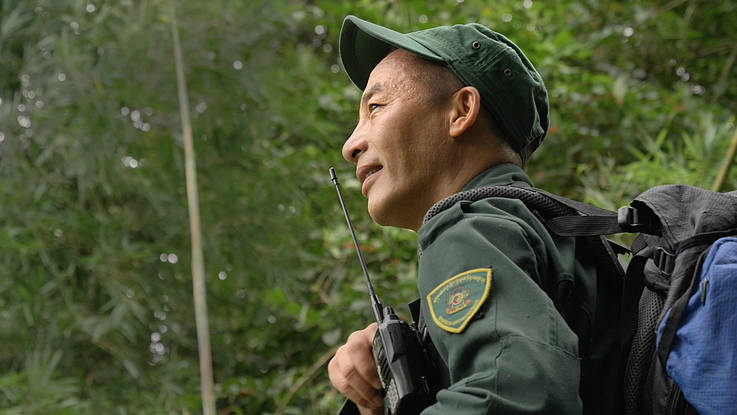The WWF is run at a local level by the following offices...
In Bhutan, another extraordinary tale of tiger recovery has been unfolding over the past decade. At the heart of this story is the Royal Manas National Park, where tigers more than doubled since 2010.
In 2019, Royal Manas National Park along with Jigme Singye Wangchuck National Park - its neighbour to the north - were awarded CA|TS accreditation. The accolade, ‘Conservation Assured Tiger Standards’, indicates that the two parks have achieved the highest global standards of tiger conservation, securing them as safe havens for the species’ recovery.

Meanwhile, just over 100 kilometers east of Royal Manas National Park and connected via a corridor, a much smaller and lesser-known tiger habitat is also seeing the effects of conservation efforts.
Ugyen Tshering is the park manager of Jomotshangkha Wildlife Sanctuary, one of ten protected areas in Bhutan. He smiles a beaming grin as he introduces himself via Zoom call.

Jomotshangkha was previously home to one lone tiger, but a recent camera trap image from late 2019 has revealed the presence of at least one more individual. This is the first additional tiger documented in Jomotshangkha since the 2015 national survey, and indicates tigers could be using wildlife corridors to disperse from Royal Manas National Park.
“I was delighted to see the pictures of a new tiger whilst doing our annual tiger monitoring, which was supported by WWF,” explains Ugyen. “In Bhutan tigers have a special place in our culture and society. They are considered to be godly animals, and when I go to the communities to talk to people they are proud to say that a tiger has visited their forest.”

More than just a source of pride, Ugyen explains that the communities experience indirect benefits from tiger conservation in the area too.
“For instance, if we want to conserve a tiger then we need to conserve a large area of healthy forest. Healthy forest means that we have clean air and clean water. When we have a healthy forest, then we are also protected from landslides and erosion. This is important, because in Bhutan landslides and erosion are very common. Having healthy forests means we can prevent natural disasters.”
As for the challenges, poaching remains a threat to Bhutan’s growing tiger population in Southern Bhutan “but in Jomotshangkha we haven’t come across challenges like livestock predation, which is increasingly becoming a problem for some communities in other parts of Bhutan,” says Ugyen.
“My dream is that tigers and communities live in harmony,” he adds. But Ugyen also acknowledges that a huge task lies ahead. With a growing tiger population in Jomotshangkha, “people’s tolerances towards tigers may be put to the test in the near future,” he says.

For tigers and humans to thrive in Bhutan people need to be at the heart of conservation efforts.
“We need to build income generation opportunities and support communities to be self-sufficient,” says Ugyen. “If farmers economically benefit from tiger conservation, if they are lifted from poverty and have a well established economic-baseline, they will help us to protect tigers.”
Despite its small size at just 362 square kilometers, Jomotshangkha is part of a much bigger conservation effort in Bhutan and India. As well as being connected to Royal Manas via a corridor, it is also part of a 6,500 square kilometer transboundary conservation area known as TRaMCA (Transboundary Manas Conservation Area) which extends along south-eastern Bhutan and Northeastern India, forming a critical mosaic of conservation spaces.
TX2 is the global goal to double wild tiger numbers by 2022, the next lunar year of the tiger. While some tiger range countries have made significant progress, this big cat still faces threats from poaching and habitat loss and fragmentation. In Southeast Asia, a snaring crisis is decimating wildlife, impacting tigers and their prey. WWF is working with partners, governments and communities to secure the future for tigers in all tiger range countries, and to reintroduce the tiger to its historic range in Kazakhstan and Cambodia.